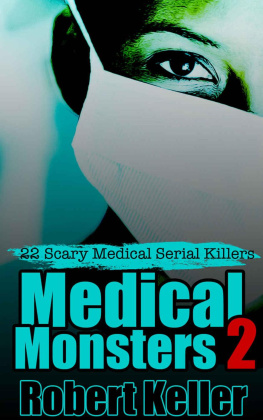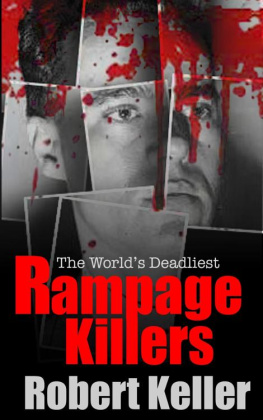Keller - True Crime: Soviet Monsters
Here you can read online Keller - True Crime: Soviet Monsters full text of the book (entire story) in english for free. Download pdf and epub, get meaning, cover and reviews about this ebook. year: 2016, genre: Detective and thriller. Description of the work, (preface) as well as reviews are available. Best literature library LitArk.com created for fans of good reading and offers a wide selection of genres:
Romance novel
Science fiction
Adventure
Detective
Science
History
Home and family
Prose
Art
Politics
Computer
Non-fiction
Religion
Business
Children
Humor
Choose a favorite category and find really read worthwhile books. Enjoy immersion in the world of imagination, feel the emotions of the characters or learn something new for yourself, make an fascinating discovery.
- Book:True Crime: Soviet Monsters
- Author:
- Genre:
- Year:2016
- Rating:5 / 5
- Favourites:Add to favourites
- Your mark:
- 100
- 1
- 2
- 3
- 4
- 5
True Crime: Soviet Monsters: summary, description and annotation
We offer to read an annotation, description, summary or preface (depends on what the author of the book "True Crime: Soviet Monsters" wrote himself). If you haven't found the necessary information about the book — write in the comments, we will try to find it.
Keller: author's other books
Who wrote True Crime: Soviet Monsters? Find out the surname, the name of the author of the book and a list of all author's works by series.
True Crime: Soviet Monsters — read online for free the complete book (whole text) full work
Below is the text of the book, divided by pages. System saving the place of the last page read, allows you to conveniently read the book "True Crime: Soviet Monsters" online for free, without having to search again every time where you left off. Put a bookmark, and you can go to the page where you finished reading at any time.
Font size:
Interval:
Bookmark:
Soviet
Monsters
Terrifying Serial Killers from
Russia & the former Soviet States
Robert Keller
PUBLISHED BY:
Robert Keller
Copyright 2016
All rights reserved.
No part of this publication may be copied or reproduced in any format, electronic or otherwise, without the prior, written consent of the copyright holder and publisher. This book is for informational and entertainment purposes only and the author and publisher will not be held responsible for the misuse of information contain herein, whether deliberate or incidental.
Much research, from a variety of sources, has gone into the compilation of this material. To the best knowledge of the author and publisher, the material contained herein is factually correct. Neither the publisher, nor author will be held responsible for any inaccuracies.

: known as Metal Fang due to his unique dental work, Dzhumagaliev served up the flesh of his victims to his unsuspecting dinner guests.
: inventive killer who posed as a famous movie director to lure his victims, who he drugged and raped before killing them by strangulation, stabbing, or drowning.
: Distraught after his girlfriend abandoned him, Mikhasevich turned his ire on the women of a small Belarussian town, murdering 33 of them.
: a killer so brutal, so bloodthirsty, that the Ukrainian government mobilized an entire army unit to stop him.
: Sex obsessed slayer who preyed on the children of Irkutsk, claiming at least 13 victims during the 1980s.
: Deadly teenaged duo who recorded their sick crimes on video and posted them on the internet.
: terrorized Moscow in the 1920s, beating and strangling 33 men to death for the change in their pockets.
: the Soviet Unions most fearsome serial killer. Chikatilo slaughtered at least 56 women and children, literally tearing them apart.
: 68-year-old female serial killer who mutilated her victims and may well have cannibalized their corpses.
: ex-homicide detective who used his knowledge of forensics to evade the Ukrainian police for over 20 years, during which he killed 100 times.
: inflicted such horrific mutilations on his 30 victims that the police refused to release the details, even after he was convicted.
: witnessing a fatal auto wreck turned this apparently respectable family man into a sadistic torture slayer of children.
: wannabe hitmen who murdered over 16 people in order to practice their killing skills.
: Siberian cannibal who preyed on street children, slaughtering them in his filthy apartment and handing over their flesh to his mother to cook.
Tamara Ivanyutina

In the early months of 1987, a school located in Kiev, Ukraine suffered a double tragedy. Two staff members died in quick succession, both with similar, inexplicable symptoms. The first of these was the school Partorg (a role that encompassed responsibility for ideological education as well as human resources); the second was the nutrition nurse, a woman in her twenties, who had appeared to be in good physical health. Doctors who examined the two were baffled by their symptoms, which included chronic joint pain and almost complete hair loss. Unable to determine the cause behind these afflictions, they fell back on the diagnosis prevalent in Soviet medicine at that time. According to their death certificates, both victims had died of heart failure.
A short while later, on an afternoon in March of 1987, a Kiev hospital was suddenly inundated with a rash of emergency admissions. Several desperately ill children arrived almost simultaneously, all of them writhing in agony. The youngsters had been picked up at various locations, although a common link was soon established. They all attended the same school. Then, as doctors fought desperately to stabilize their young patients, a call came in from the school itself. Two adults a teacher and a refrigerator repair man had been struck down by the same mystery ailment. An ambulance was immediately dispatched to bring them to the hospital. Within 24 hours, both adults, as well as two of the eleven children admitted on that horrific day, had died in agony.
A link was quickly established between those deaths and the two that had occurred earlier in the year at the same school. The question was, what had caused them?
Initially, it was speculated that some sort of infection was responsible. However, the symptoms displayed by the patients were inconsistent with this. None, for example, had shown any evidence of fever.
Then, it was thought the victims had been exposed to some sort of poison, radioactive material, perhaps. The Chernobyl nuclear disaster had occurred less than a year prior. Had radioactive material somehow made it to this Kiev school? Not wanting to take any chances, hospital administrators contacted the Sanitation and Epidemics Station (Russias version of the CDC). It wasnt long before SES technicians in protective suits were wandering the halls of the school with Geiger counters. The results, however, showed no signs of contamination.
Meanwhile, back at the hospital, the bloodwork of all the patients, including the four who had died, was back. And the doctors were in for a surprise. All had tested positive for the poison thallium. Tests were then ordered on the exhumed corpses of the two earlier victims and returned a similar result.
With the discovery of thallium in the bodies, the symptoms made perfect sense. But while that question was now answered, another was raised. How had the victims come into contact with the deadly substance? SES officials suspected accidental exposure, perhaps as a result of careless pest control measures. The school building was thus subjected to a thorough sweep. No trace of the poison was found.
That left only one explanation for the six deaths - deliberate poisoning. What had started out as the suspected leak of radioactive materials was now a homicide investigation.
Next pageFont size:
Interval:
Bookmark:
Similar books «True Crime: Soviet Monsters»
Look at similar books to True Crime: Soviet Monsters. We have selected literature similar in name and meaning in the hope of providing readers with more options to find new, interesting, not yet read works.
Discussion, reviews of the book True Crime: Soviet Monsters and just readers' own opinions. Leave your comments, write what you think about the work, its meaning or the main characters. Specify what exactly you liked and what you didn't like, and why you think so.


















